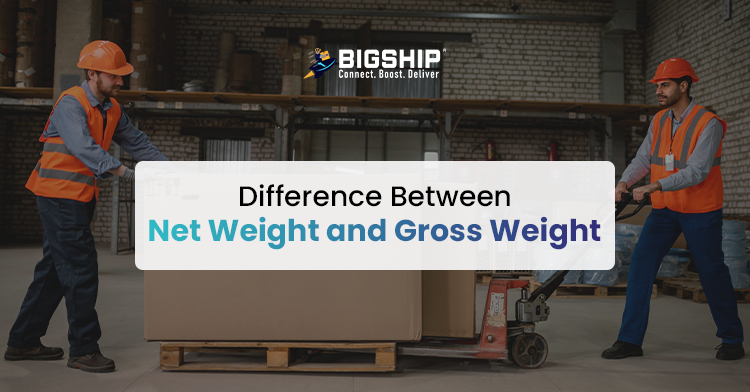Net Weight Vs Gross Weight| Meaning, Calculation, and Importance

2. Calculation of Net Weight
3. Gross Weight Meaning
4. Calculation of Gross Weight
5. Net Weight vs Gross Weight in Shipping
6. What are Net Weight, Gross Weight, and Tare Weight?
7. Role of Weight Measurement in Shipping
8. Net Weight Vs Gross Weight
9. Additional Tips For Accurate Net & Gross Weight Calculation
10. Mistakes To Avoid When Understanding Net Vs Gross Weight
11. Conclusion
12. FAQs
Net weight and gross weight are vital concepts in the logistics and shipping industry. These measurements influence everything from shipping costs to safety compliance and smooth customs clearance.
Knowing their differences and accurate calculations ensures efficiency and cost-effectiveness in transportation. Each term plays a distinct role in managing goods, packaging, and shipments effectively. Misunderstanding them can lead to errors, delays, or even increased expenses.

This blog will help you clearly understand the differences between gross vs net weight, along with their calculations and significance in shipping operations.
Net Weight Meaning
Net weight refers to the weight of the actual goods or contents inside a package, excluding the weight of packaging materials, containers, or other external factors. In simpler terms, it represents the pure weight of the product itself.
For manufacturers, net weight helps determine the exact amount of raw materials required to produce an item. In retail, it’s prominently displayed on product labels to inform customers about the exact quantity of the product they’re purchasing, without considering the weight of the packaging.
Moreover, in logistics and shipping, net weight is a key factor for calculating costs and adhering to regulatory requirements related to weight limits.
Calculation of Net Weight
Calculating net weight is quite simple. You can start by weighing the product along with its packaging or container to get the total weight. Next, determine the tare weight, which is the weight of the packaging or container. Finally, subtract the tare weight from the total weight to find the net weight.
The formula for the net weight is given below:
Net weight = Total weight – Tare weight
This method ensures you get the exact weight of the product without any added weight from the packaging.
Gross Weight Meaning
Gross weight refers to the total weight of a product, including the product itself (which is the net weight), its immediate packaging, and any additional materials used for transportation. This can include items like crates, boxes, pallets, or protective materials such as bubble wrap used to secure the goods during shipping.
Understanding gross weight is essential for logistics and safety. Shipping costs are often calculated based on gross weight which makes it a key factor for determining freight charges. Additionally, knowing the gross weight helps ensure vehicles like trucks, ships, or planes are not overloaded which helps in reducing safety risks and maintaining efficiency in transit.
In short, gross weight is a vital measure for not only the cost but also the safety in the transportation of goods.
Calculation of Gross Weight
The calculation of gross weight is straightforward. Start with finding the net weight of the product, which is the weight of the product alone. Then, add the weight of its packaging, such as boxes, wrapping, or crates. For certain shipments, you may also need to include the weight of the container or vehicle used for transport.
The formula for gross weight is:
Gross weight = Net weight + Packaging weight + Container weight (only if applicable)
Net Weight vs Gross Weight in Shipping
In shipping, understanding net weight vs gross weight is essential. Net weight refers to the weight of the goods alone, excluding packaging and transport materials. It helps determine accurate shipping costs by focusing solely on the product’s weight.
On the other hand, gross weight, however, includes the cargo, packaging, and additional transport materials. This total weight is crucial for safety compliance, calculating shipping expenses, and adhering to regulations. Knowing the difference between net and gross weight ensures precision and efficiency in shipping operations.
What are Net Weight, Gross Weight, and Tare Weight?
Net weight, gross weight, and tare weight are key terms in logistics and shipping. We have already discussed net weight and gross weight. Tare weight refers to the weight of the empty packaging or container used to hold goods, such as boxes, pallets, or protective wraps.
The relationship between these weights is essential for accurate shipping and cost calculations.
Here are the formulas:
Gross weight = Net weight + Tare weight
Net weight = Gross weight – Tare weight
Role of Weight Measurement in Shipping
Weight measurement plays an important role in shipping. Some of the reasons are mentioned below:
Following Legal and Safety Standards: Transport companies must stick to strict rules about how much cargo they can carry. Hence, accurate net weight and gross weight keep shipments within safe limits by protecting workers and equipment.
Smoother Customs Process: When shipping internationally, customs need accurate details about your shipment’s weight. Errors in gross weight or net weight can cause delays, fines, or even confiscation of goods. Proper weight declarations make customs clearance much easier.
Managing Shipping Cost Smartly: Shipping companies calculate costs based on weight. Knowing the exact net weight and gross weight of your shipment ensures you pay the correct charges and avoid unexpected expenses.
Avoiding Overloading Issues: Overloading vehicles can damage goods and equipment and cause delays. By measuring net weight and gross weight properly, you can avoid overloading risks and ensure smooth deliveries.
Net Weight Vs Gross Weight
Here are some differences between net weight and gross weight that will help you better understand each term.
| Net Weight | Gross Weight |
| It is the weight of the goods alone, without packaging or accessories. | It is the total weight, including goods, packaging, and shipping accessories. |
| Net weight does not include tare weight. | Gross weight also includes tare weight. |
| It is consistent across all transport modes. | Gross weight may vary based on transportation methods. |
| It is used for pricing goods and inventory management. | It is crucial for shipping costs and safety compliance. |
Additional Tips For Accurate Net & Gross Weight Calculation
We know that accurate measurement of net weight and gross weight is crucial for a smooth shipping process. Here are some additional tips for their precise calculation.
Use Reliable Weighing Equipment: Always use properly calibrated and high-quality weighing scales. Hence, regularly check and maintain the equipment to ensure it provides precise readings.
Train Your Team: Make sure your staff knows how to weigh goods correctly and handle weighing equipment properly. Proper training reduces errors and saves time.
Label Weight Details Clearly: Clearly label the net weight, gross weight, and tare weight on your shipments. This helps avoid confusion and ensures compliance with shipping requirements.
Stay Updated on Shipping Rules: Shipping regulations, especially for international shipments, may change. Thus, consult with freight companies or experts to ensure your weight measurements align with the latest rules.
Mistakes To Avoid When Understanding Net Vs Gross Weight
Many people get confused when dealing with net weight vs gross weight. Here are some common mistakes and misconceptions to watch out for:
Mixing Up Gross and Net Weight: One of the most frequent mistakes is using “gross weight” and “net weight” as if they mean the same thing. Net weight is the weight of the goods only. Gross weight is the sum total of weight of the goods, packaging, and accessories. Understanding this difference is key to avoiding errors in shipping calculations.
Skipping Tare Weight in Calculations: Tare weight (the weight of packaging and containers) is a crucial part of gross weight. Forgetting to include tare weight can result in incorrect weight declarations which can lead to delays or fines during shipping. Thus it is always recommended to double-check your calculations to include everything.
Overlooking the Importance of Accurate Records: Accurate weight records are essential for audits, customs processes, and cost management. Mistakes in net weight and gross weight can lead to unnecessary complications.
Using Inaccurate Weighing Tools: Old weighing scales can give you incorrect readings. This can lead to problems like paying too much for shipping or violating carrier regulations. Make sure you use reliable and calibrated equipment for accurate weight measurements.
Conclusion
Net and gross weight are important factors to consider during the process of shipping. Accurate weight measurements prevent delays, save costs, and ensure compliance with shipping regulations.
Bigship, a prominent courier aggregator, takes the complexity out of the process by offering seamless logistics solutions. With its expertise, you can manage shipments effortlessly and focus on growing your business. Choose Bigship for reliable shipping services that keep your operations running smoothly.
Bigship, your hassle-free shipping partner, is just a sign-up away!
FAQs
Ques: What is Net Weight in Shipping?
Ans: Net weight refers to the weight of the product itself. It represents the pure weight of the goods.
Ques: Why is gross weight important in logistics?
Ans: Gross weight is essential for calculating shipping costs, ensuring vehicles aren’t overloaded, and complying with safety regulations.
Ques: What happens if weight measurements are inaccurate?
Ans: Inaccurate weight measurements can lead to overpayment of shipping costs, delays at customs, or safety hazards due to overloading.




